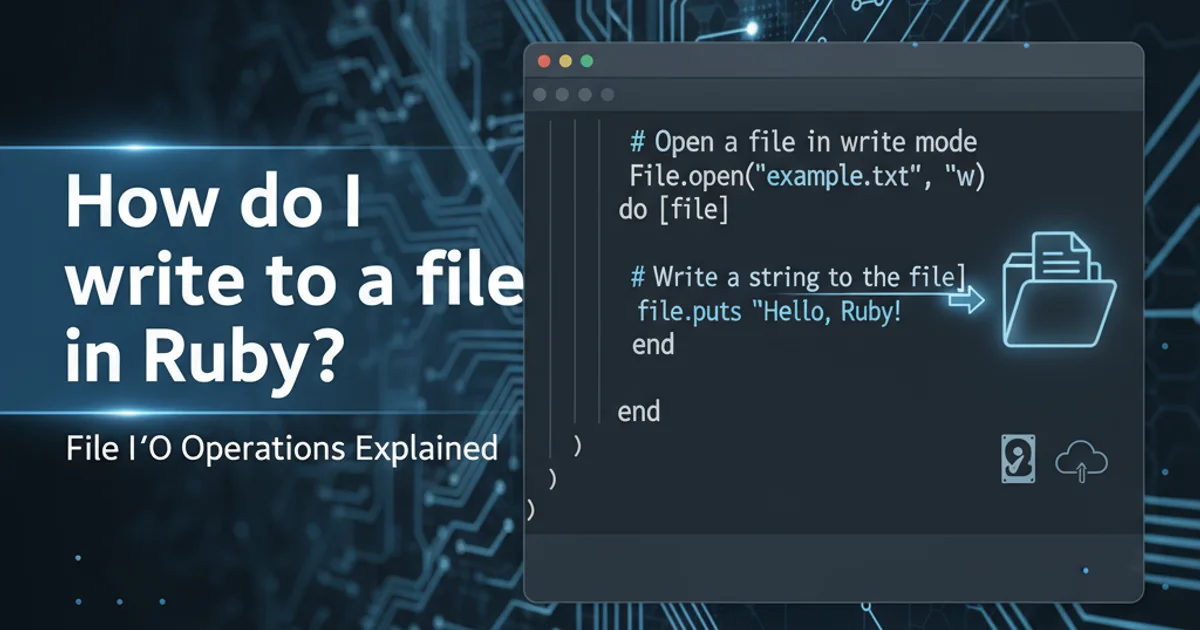How do I write to a file in Ruby?
Categories:
Mastering File I/O: How to Write to a File in Ruby

Learn the essential techniques for writing data to files in Ruby, covering basic operations, appending content, and handling errors gracefully.
Writing data to files is a fundamental operation in many programming tasks, from logging application events to saving user configurations or generating reports. Ruby provides several straightforward and powerful ways to interact with the file system. This article will guide you through the most common methods for writing to files, including creating new files, overwriting existing ones, appending data, and ensuring proper resource management.
Basic File Writing: Overwriting or Creating Files
The simplest way to write to a file in Ruby is by opening it in write mode ('w'). If the file specified by the path does not exist, Ruby will create it. If the file already exists, its entire content will be truncated (emptied) before any new data is written. This is crucial to remember to avoid accidental data loss.
# Open a file in write mode ('w')
File.open("my_new_file.txt", "w") do |file|
file.write("Hello, Ruby file writing!\n")
file.puts("This is another line.")
end
puts "Content written to my_new_file.txt (overwriting if it existed)."
Writing to a file using File.open in write mode ('w').
'w' mode will overwrite the entire content of an existing file. If you need to preserve existing data, use append mode ('a') instead.Appending Data to an Existing File
Often, you'll want to add new data to the end of a file without deleting its current contents. For this, Ruby offers the append mode ('a'). When a file is opened in append mode, the file pointer is automatically positioned at the end of the file, ready for new data.
# Open a file in append mode ('a')
File.open("my_new_file.txt", "a") do |file|
file.puts("This line is appended.")
file.write("And this is also appended.\n")
end
puts "Content appended to my_new_file.txt."
Appending data to a file using File.open in append mode ('a').
Simplified Writing with File.write and File.binwrite
For simple string or binary data writing, Ruby provides convenience methods File.write and File.binwrite. These methods handle opening, writing, and closing the file in a single call, making your code more concise. File.write defaults to 'w' mode and handles text, while File.binwrite is for binary data and also defaults to 'w' mode.
# Using File.write (overwrites by default)
File.write("simple_text.txt", "This is some simple text.\n")
puts "simple_text.txt created/overwritten."
# Appending with File.write (requires mode option)
File.write("simple_text.txt", "This text is appended.\n", mode: "a")
puts "simple_text.txt appended."
# Using File.binwrite for binary data (e.g., image bytes)
# For demonstration, we'll use a string converted to bytes
binary_data = "\xDE\xAD\xBE\xEF".force_encoding(Encoding::BINARY)
File.binwrite("binary_data.bin", binary_data)
puts "binary_data.bin created/overwritten."
Using File.write and File.binwrite for concise file operations.
File.open is generally preferred as it automatically handles closing the file, even if errors occur. For simple, one-off writes, File.write is very convenient.Understanding File Modes and Resource Management
When you open a file, you specify a 'mode' that dictates how you can interact with it. The most common writing modes are 'w' (write, overwrite), 'a' (append), and 'w+' (read/write, overwrite). It's critical to ensure that files are properly closed after you're done writing to them to prevent data corruption or resource leaks. The block form of File.open is the safest way to do this, as it guarantees the file is closed automatically.
flowchart TD
A[Start File Write Process]
B{File Exists?}
C[Open in 'w' mode]
D[Truncate File]
E[Open in 'a' mode]
F[Seek to End of File]
G[Write Data]
H[Close File]
I[End File Write Process]
A --> B
B -- Yes, 'w' mode --> C
B -- No, 'w' mode --> C
C --> D
D --> G
B -- Yes, 'a' mode --> E
B -- No, 'a' mode --> E
E --> F
F --> G
G --> H
H --> IFlowchart illustrating file writing logic with 'w' and 'a' modes.
Error Handling During File Operations
File operations can fail for various reasons, such as insufficient permissions, disk full errors, or invalid paths. It's good practice to wrap file writing code in begin...rescue...end blocks to gracefully handle these exceptions.
begin
File.open("/nonexistent_directory/output.txt", "w") do |file|
file.puts("Attempting to write to an invalid path.")
end
rescue Errno::ENOENT => e
puts "Error: Directory not found or invalid path. #{e.message}"
rescue IOError => e
puts "Error: An I/O error occurred. #{e.message}"
rescue => e
puts "An unexpected error occurred: #{e.message}"
end
puts "Attempted file write with error handling."
Example of error handling for file writing operations.
1. Choose the Right Mode
Decide whether you need to overwrite ('w'), append ('a'), or read/write ('w+', 'r+') based on your requirements. If the file might not exist, 'w' and 'a' will create it.
2. Open the File Safely
Always use the block form of File.open (File.open('filename', 'mode') do |file| ... end) to ensure the file is automatically closed, even if errors occur during writing.
3. Write Your Data
Use file.write for raw string output or file.puts to write a string followed by a newline character. For binary data, consider File.binwrite or file.write with appropriate encoding.
4. Implement Error Handling
Wrap your file operations in begin...rescue...end blocks to catch potential IOError, Errno::ENOENT, or other exceptions, providing robust application behavior.